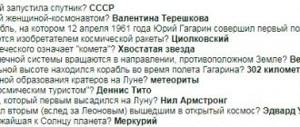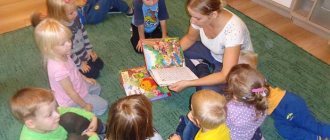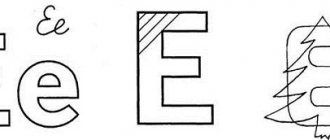Features of the formation of a children's team in elementary school
For younger schoolchildren, the predominant type of activity is gaming.
Through play, a child tries on social roles and is included in the system of social relations. It is noteworthy that the main motive of such didactic games is not the manipulation of objects, but the communication of children with each other, their interaction. When using didactic games to unite a children's team, it is necessary to take into account that unity occurs gradually and goes through different stages. Therefore, in each class, the goals and tasks implemented in the course of working on team building differ significantly from each other. It is important for the teacher to take this into account when choosing a game, focusing on the results that he plans to get after playing it.
Games during recess 1st grade in the corridor
- Knock down a cone - a cone is made from cardboard or paper. The guys knock him down with a wad of paper.
- Accurate - the student is blindfolded, with a ball a couple of meters away from him. He must push the ball with his foot, the others can tell him to go to the right or to the left.
- Guess what - the office supplies are loaded into the bag. You need to find the item, guess it and show it to everyone.
- Forfeits - everyone throws one of their things into the box (you can have a pencil or an eraser). Then the driver chooses an item and gives its “owner” a task - to sing, jump, etc.
- Cockfighting - you need to push each other with your shoulder, jumping on one leg, so that the opponent loses his balance and stands on both legs.
Stages of team building for children in elementary school
1 class
In the 1st grade, the team is at the nascent stage. Children know little about each other and do not have established communication connections with each other. The teacher can offer them games that will help them get to know each other better, establish friendly relationships, and even unite in microgroups (on the principles of intuitive sympathy).
2nd grade
2nd grade is the period of formation of the foundations of the team. It is at this stage that interpersonal conflicts most often arise based on different value guidelines in children, and “isolated” schoolchildren may appear. Another problem is the manifestation of psychological barriers: if first-graders behave sincerely and openly, then in the second grade children may become withdrawn, fearful, and hysterical.
Didactic games conducted with second-graders should be aimed at developing general rules of behavior in a team, developing interaction skills, resolving and preventing conflict situations, and overcoming psychological problems.
3rd grade
In 3rd grade, team building occurs. Children are ready to carry out social assignments in the classroom and show interest in joint activities. At the same time, it is during this period that the personal qualities of each child are most fully revealed, children realize their individuality.
When choosing didactic games for this stage, it is necessary to give preference to those that will enable the child to feel like part of a team, show the significance of his activities for the whole class, encourage children to unite in groups to achieve their goals, and show support for each other.
4th grade
4th grade students can be characterized as an established team, whose members show interest in socially significant activities and can evaluate the behavior of their classmates and bear common responsibility. In such a team there is an asset that leads the life of the class; children with leadership needs stand out.
In didactic games conducted in 4th grade, children should be invited to act as an organizer, teach them mutual understanding and the ability to coordinate their actions with classmates, and coordinate common behavior. Games are recommended in which schoolchildren must come up with a way to implement the assigned task and have the opportunity to choose their own course of action. It is worth paying attention to the plot of games and moving from children's scenarios to practical situations.
Team building games for 1st grade
The simplest game in which children can get to know each other is “Ball” . Its essence is that children stand in a circle and one child receives a ball. He must say his name and pass the ball to his neighbor, who also introduces himself and passes the ball further. This continues until each first grader says his name.
This game can be played several times during the first two months, offering other tasks for children:
- give your first and last name;
- name your favorite activity (toy, animal, color);
- say your name and parents' names, etc.
To help children quickly remember the names of classmates, it is recommended to play the game “We are going on a hike ,” which uses the association technique. Children are told that they need to pack for a hike and take a lot of things with them. Everyone should say the phrase “My name is..., and I take with me...”. In this case, the child must indicate an object whose name begins with the same letter as his name. This game can be played several times, inviting children to get ready for the library, a trip to the sea, school, etc.
The teaming game “Border” . The rules are simple: children line up in a line, the teacher draws a boundary at a distance of 2-3 meters from them. Then he announces the task:
- who has a brother;
- who is 7 years old;
- who recently went to the cinema;
- who likes to draw;
- who has a cat at home, etc.
Schoolchildren to whom the indicated sign applies must cross this line and gather on the other side. The information that children learn after this game can serve as a reason for further closer communication.
Games at school
Games for first graders in the classroomA kind of organizational and obligatory moment in the lesson are games conducted by the teacher in the classroom. They not only have a positive effect on the child’s mental development, but also allow children who are not yet fully adapted to school to take a break for rest.
Mickey Mouse
Typically, desks in a classroom are arranged in 3 rows. The teacher tells the children that each row; these are commands. The first group (1st row) should shout “Miki” loudly when the teacher raises his right hand up. The second team (3rd row) shouts “Mouse” if they raise their left hand. And the third group (middle row) should loudly shout “Mouse” if the teacher crosses his arms.
Note. At the beginning of the game, the teacher warns the children that they need to be very careful, as he can deliberately confuse them, for example, raise two hands up at the same time.
"Motor".
It’s a unique way to conduct it when the kids are tired and begin to violate discipline in the classroom. Games like these with first-graders in class help them “make some noise” and continue to work in complete silence.
So, the teacher asks the children how the engine in the car works, what sound it makes. The teacher asks the students to imagine that they are; This is one motor, and he is the driver who will regulate it. When the “lever” hand goes up, the motor should work loudly (pronounce the sound “r-r-r”), if it goes down, it works more quietly.
Imagination game
Game "Show the sounds"
The teacher holds cards with pictures of animals, birds, and objects. The teacher shows the class one card at a time. Children must, without naming what is shown in the picture, “say” the word with sound and depict it using facial expressions and gestures. For example, a cat. First-graders say “meow-meow” and show their claws.
Game to relieve muscle strain
Games for first-graders in the classroom should also be complex, especially in writing and math lessons, when fine motor skills and back muscles are involved.
1. "Rain."
This game relieves stress well and is very popular with children. The teacher tells the children to imagine that it is raining. The teacher comments, and the students repeat the movements with him.
“It started to rain” (children raise their hand in front of them, palm up).
“First one drop” (hit the palm with one finger of the other hand).
“Then two drops” (two fingers, etc.).
“And then it started to rain heavily” (students clap their hands).
“The rain gradually began to subside. Four drops, three, two, one” (also shown in reverse order).
“The rain has stopped. The sun is out!” (children raise their hands up).
Game to develop reaction speed
. "Such different animals."
First-graders get up from their desks. The game is played on site. The teacher pronounces words (4-5), and the children imitate what the class teacher told them, and the pace of the game gradually increases. For example, "heron"; students stand on one leg, “bunny”; they put their hands on the tops of their heads and jump up, the “elephant” stretches one arm forward, like a trunk, etc.
Note. At the beginning of the game, the teacher must demonstrate the movements himself.
These games for first-graders in the classroom allow you to relieve emotional and physical stress in a short period of time, concentrate on the lesson during further work, and even help children gradually cope with their complexes.
Games for first graders at recess
Class unity game
1. "Mixer"
The guys are standing in a circle. The driver is in the center. He says: “Swap places with those who have 1 characteristic (for example, long hair, someone wearing sneakers, someone who likes cakes, etc.).” At the moment of movement, the driver must take one of the vacant seats. Whoever does not have time to get up on time stands in the center of the circle.
This game allows not only the children, but also the teacher to learn about each other, and also develops attention and speed of reaction.
2. "Numbers"
This game is similar to the previous one. First-graders count in order, standing in a circle and each remembering their number. Then one of those willing goes to the center and names any 2 numbers (taking into account the calculation), which must change places, and the driver takes one of the places as quickly as possible. Those who did not have time stand in the center and continue the game.
3. "Building"
At the teacher’s command, the class should line up:
; by height,
; by hair length; by eye color, etc.
4. "Rope"
Students, holding onto a rope or jump rope, must use it to build some kind of figure, letter, etc. For example, a circle, the letter “P”, “G”, etc.
Game to identify the leader in a group
1. "Crocodile"
The guys squat, forming a circle. There is also a teacher here who pronounces the word “Crocodile” and at the same time shows 1, 2, 5; on his fingers, i.e. this number will indicate the number of guys who should rise. Everyone gets up at will
The teacher carefully observes and draws conclusions for himself: those boys and girls who rose most often are potential leaders in the class. In addition, this game also helps children repeat counting.
Outdoor games for first graders
The schoolyard, as you know, allows not only outdoor games, but also those where loud shouting and noise are not prohibited.
Warm up game
"Thrush"
The class is divided into 2 teams. They stand facing in 2 ranks. Then they repeat the words and movements, pointing at each other:
; "You ; blackbird, I; thrush",
; "You have a nose, I have a nose"
; “Your cheeks are red, my cheeks are red,”
; “Your lips are scarlet, my lips are scarlet,”
“We are two friends who love each other!” (hug).
Outdoor games for first-graders are also good because, thanks to the large space, it is possible to conduct general games that require certain actions from children.
Team-story game
1. "Mammoths"
The whole class participates. The teacher distributes roles between first-graders: mammoths (most of the class), rescuer; 1 child, hunters (2-3 pairs); The two of them should move only holding hands. Their task; catch a mammoth. To do this, you need to catch the “animal” by forming a ring, holding it with your free hands. After this, the hunters take the prey in this position to a place agreed upon in advance. If the rescuer does not have time to free the mammoth, i.e. touch it with your hand, then that child is out of the game
The rescuer can only “release” the victim 3 times. If a child falls into the clutches of hunters more than expected, then he also leaves the game
2. “Help me out!”
Among the students, 1-2 drivers are selected, who must “freeze” all moving children with a touch of their hand. If someone is still frozen, then he should stand in place with his arms to the sides, feet shoulder-width apart and shout the following words loudly
“Hurry up and come running
And you help me out!”
The remaining participants (one of them) can “rescue” him if they crawl under the feet of the “frozen” one. Only then can the “saved” person continue the game.
Games with sports equipment
1. “Vegetables and fruits”
The driver throws the ball one by one to the players standing in the same line, naming vegetables and fruits in any order. If it is a vegetable, for example a potato, you need to catch the ball and sit down; if it is a fruit; apple, then you should also catch the ball and then jump
2. “Fisherman”
The guys stand in a circle, in the center is a first-grader with a jump rope. He spins it clockwise, and everyone else has to jump up so as not to touch the jump rope with their feet. Those who did not have time or hesitated become “caught fish”. Then the driver and the fish change places.
Thanks to game situations, children learn to behave correctly, think logically and become accustomed to sports.
Team building games for 2nd grade
“Hello, Friend” can overcome a child’s uncertainty and fear of doing something wrong . In it, children are invited to repeat the ready-made greeting ritual. To do this, the class is divided into two groups. The children of the first group stand in a circle, and the participants of the second group go inside it and also stand in a circle, turning to face their classmates. Thus, you should get pairs who need to greet each other, repeating after the teacher his words and movements:
After this, the guys from the inner circle need to move to the right, moving to other partners, and say the greeting again. This can be repeated several times. In a situation where everyone acts according to the same pattern, the child will feel like an equal member of the team, will be able to relax and overcome isolation.
Children in second grade should be taught to talk about their feelings and be able to understand the moods and emotions of others. They have this opportunity during the game “What is the mood like? ” To carry it out, it is better to arrange the children in a circle and invite them to continue the phrase “My mood today is like...”. A specific topic for comparison can be set: season, color, flower, animal, etc. To show an example of an answer, the teacher speaks first. At the end of the game, you can have a discussion, determine who is angry or sad today and why, and also invite children to help their classmates improve their mood.
If children in the class cannot yet or are embarrassed to express their mood in words, you can suggest using facial expressions, postures, and gestures for this. In the game “Mushroom Picking,” you need to choose a mushroom picker, and ask the rest of the students to draw any mushroom, but in such a way that it is clear from its appearance whether it is edible or not. A mushroom picker, examining frozen children, should divide them into two groups. After this, you can invite the children to express why they wanted to depict just such a mushroom.
“Ships and Rocks” is suitable for developing primary interaction skills . Schoolchildren should be divided into two groups. Some will be “rocks” - they should position themselves around the room and sit down. The participants of the other group are “ships”; they must close their eyes and begin to move around the class in a chaotic manner. If such a “ship” approaches some “rock,” then the child who represents it needs to hiss, imitating the sound of the sea surf. All participants must try to avoid a shipwreck.
After the game, it is important to discuss incidents of collision and talk about friendly support, which helps to avoid trouble. Separately, it is necessary to point out the behavior of the guys who did not specifically make any sounds so that the “ship” would bump into them (if such a thing happened). During the discussion, some rules of behavior in the team can be developed: do not create trouble for each other, provide assistance, etc.
You can accustom children to general rules of behavior and develop the ability to act according to a given model during the game for primary grades “Fun Game of Spoons” . Children squat in a circle and fold their hands behind their backs. Spoons are placed inside the circle, the number of which is one less than the number of participants. Assignment for the children: when they hear the word “spoon,” they must pick up one spoon each. Whoever from the group does not have time to do this leaves the game and removes one spoon from the circle. In the end, the most attentive and diligent student should remain. It is better during the game not just to name individual words to the children, but to tell some story with spoons or the Lozhkin family.
To teach children to find the right way out of conflict situations, you can play the game “Island of Conflicts” . If possible, it is worth creating an appropriate environment with the help of decorations. The schoolchildren are told that they are on an island whose inhabitants are constantly quarreling because they do not know how to behave correctly. Children are invited to try to reconcile them by offering a way out of this situation:
- the child fell into a puddle and his mother scolds him for dirtying his new trousers;
- the boy does not want to share his toys with children;
- the girl tore a book from her friend;
- a child trips his friend, etc.
After discussing such conflicts, you can formulate rules on how to behave in a team.
Interesting games during recess
- Quest - leaves with riddles are hidden in different places in the classroom, which lead the children to a new place and, ultimately, to where the object is hidden.
- Commander - children stand in front of the leader, who gives commands: jump on the left leg, sit down. Whoever did it wrong is eliminated.
- The bell rings - children join hands in a circle, two in the center of the circle. One player is blindfolded, the other has a bell. A blindfolded child must catch the one who rings the bell, indicating his location.
- Fulfill the agreement - the driver agrees in advance with the guys that when he stomps, they will also stomp in response, when he stretches out his hands to them, they will turn away, when he shakes his finger, they will nod. Then the driver quickly makes movements, and the guys fulfill the agreement.
- Long tail - the teacher names animals for the children. If it has a long tail, the children raise their right hand and wave; if it is short or does not exist, there is no need to raise their hand. The teacher always raises his hand, trying to confuse the children.
- Confusion - children hold hands and get entangled, crawling under their arms and stepping over each other. Then a student comes in, who is obliged to untangle the guys without opening their hands.
- Find out the voice - one student closes his eyes, the rest dance around. Then the student commands “Stop!” and points his finger at the player in front of him. He must say out loud: “Recognize me!” The player, without opening his eyes, guesses his classmate by voice.
- Whoever touched it , the driver turns away, several students approach him. One touches. The driver turns to his classmates and tries to guess who insulted him.
- Prohibited movement - the teacher shows the movements, the children must repeat everything except the prohibited one (agreed in advance, for example, you cannot squat).
- Catch – students are in a circle, the driver is holding the ball in the center. Then he throws it up and calls the child’s name, he must have time to catch the ball. If he doesn’t have time, he takes the driver’s place.
Unity games for 3rd grade
“Self-Portrait” will help your child express his individuality and show his inclinations . Children are given the task of drawing themselves in an unusual form: instead of eyes, depict what they like to admire, instead of a mouth - their favorite food, instead of hair - what they like to think about, etc. After completing the task, you can arrange an exhibition of paintings.
Another game of this type is the game “Business Card” . Children are asked to pick up a microphone and say their name. When everyone in the circle has done this, they start over, but add information about how old they are to their name. Then again, but this time they talk about what they can do best. The game can be continued as long as you like, giving the children new tasks: what music they like to listen to, what book they read, etc.
To convey to children the idea that even though they are all different, it is necessary to stick together and be one, it is recommended to play the game “Grapes” . Children are asked to look at a bunch of grapes, choose one grape and eat it. Then a discussion is held that the grapes may differ slightly in size, shape, shade, but all together they form a bunch to which they are firmly attached. Children should be asked to think about the following questions:
- If the grapes grew separately, would anyone notice them?
- What will happen to the grape if it doesn’t stay firmly on the branch?
- How is it easier for the wind to pluck a grape from a branch: when it is separate or as part of a large bunch?
Children will be able to clearly see that the result of a common cause depends on the contribution made by each of the team members during the game “Magic Pictures” . Divide the children into teams. Everyone receives a sheet of paper and colored markers. The task is given to draw a family of aliens (or wolves, hares, etc.). First you need to portray your mother. After this, the children exchange leaves and draw dad, then change again and continue drawing other family members. This continues until the leaves with drawings return to their owners. After this, all drawings are reviewed and the best are selected. The authors of these works name who exactly they painted.
Another option for games to bring children 6-10 years old together is the “Funny Drawing” . Schoolchildren are divided into two teams. They will draw, for example, a cow. The first participant is blindfolded and asked to draw a head. The rest take turns filling in the missing details. Then they evaluate the fruit of their joint efforts.
Children will learn the principles of cooperation and the ability to perform joint actions in the game “Siamese Twins” . The guys need to split into pairs. In each pair, the participants should stand close to each other and hug the waist. The legs that are next to each other should be secured with a rope. After this, such “twins” are asked to walk around the classroom, sit on a chair, lie down, jump, etc. Another option for the game is to hold a couple of students’ hands together and ask them to draw or write something.
There are games that encourage children to form groups. One of them is the game "Molecules" . Each child should receive a sign with a letter (number or picture). The following is the task:
- make up a word;
- make an example;
- create a recipe for borscht, etc.
Children need not only to unite, but also to properly coordinate their actions in order to restore the correct sequence.
Math games
Educational math games are aimed at strengthening oral and numerical counting skills. They are usually accompanied by dynamic unloading.
Get in order!
Two teams of 10 people each participate. The teacher sticks numbers from 5 to 15 on the backs of the participants so that they do not know their number. The team’s task is to line up in ascending order as quickly as possible, learning their number from their neighbor.
Ball exercises
Children solve common math problems much faster if the teacher throws a ball to the student to answer. In addition to mental counting, you can ask children to name the previous and next numbers. For example, the leader says “18”, the student catches the ball and answers “17 and 19”.
Guess the number
This educational game is aimed at consolidating knowledge of the number ray. The presenter guesses a number, and the players guess:
- more than 6 but less than 8;
- less than 13 but more than 11;
- more than 16, but less than 19 (trick question, there are several options).






